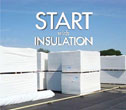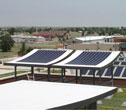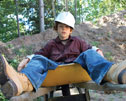Asphalt shingles with their desirable aesthetics and proven performance have been the steep-slope roofing material of choice in the U.S. for more than half a century. According to "Residential Roofing 2010: A Market Focused Update," published by Principia Partners, Exton, Pa., more than 80 percent of sales in the U.S. residential roofing market are asphalt shingles or bitumen-based roofing materials.
Shingles typically are constructed by coating a reinforcement layer with molten bitumen and covering the surface with roofing granules to protect the bitumen from harmful ultraviolet (UV) radiation while providing desirable colors.
Roofing granules usually are made from naturally occurring mineral particles that are translucent to UV radiation. However, roofing granules typically have high absorption of solar heat, so shingles tend to have low solar reflectance. As a result, asphalt shingles can reach relatively high surface temperatures during hot summer days.
Recently, there has been high demand for roofing materials that can reflect more solar heat, reducing the energy need for indoor cooling loads. This particularly is true in Sun Belt states and regions where energy costs are relatively high. Furthermore, there has been a growing trend in building codes by local building officials to mandate cool roof systems not only because of their energy benefits but also because of potential benefits to cut greenhouse gases for global warming reduction.
This is an important trend for asphalt shingles because they represent the major residential roofing material in North America. Increasing asphalt shingles' solar reflectance remains a significant challenge because the highly absorbant raw materials currently employed to make the shingles and their rough granulated surfaces tend to reduce reflectivity. This is especially true when considering the relatively dark earth-tone colors most homeowners prefer. Although higher solar reflectance can be achieved by using lighter colors or white paint, this approach becomes less effective in the residential roofing market because of aesthetics.
However, a new generation of asphalt shingles is available; these new shingles are designed to reflect solar heat while maintaining a traditional color palette through the use of roofing granules with engineered optical properties.
Standard granules
The current art of making roofing granules typically consists of selecting a suitable mineral source, quarrying and crushing rock to a certain grading or size, de-dusting and drying, coloring, curing and adding final surface treatment for shingle applications.

Figure 1: Typical CIE Color System color data of current industrial standard roofing granules
The earth-tone colors produced and used by the roofing industry typically range from light gray to black. Typical Commission Internationale de l'Eclairage (CIE) Color System color data of current industrial standard roofing granules are shown in Figure 1. Their solar reflectance values, as measured by ASTM C1549, "Standard Test Method for Determination of Solar Reflectance Near Ambient Temperature Using a Portable Solar Reflec- tometer," are shown in Figure 2.
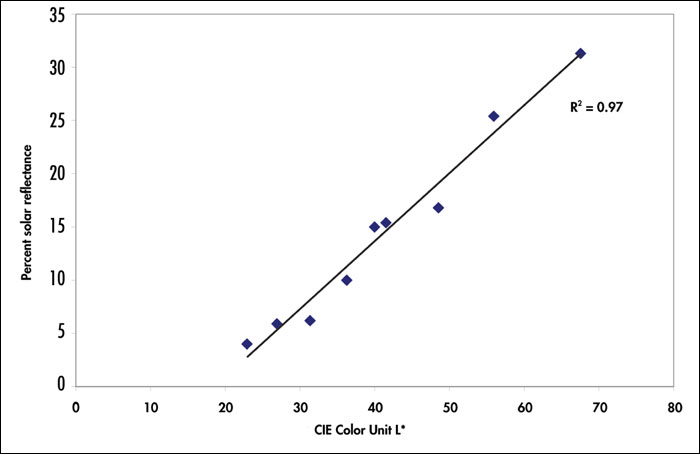
Figure 2: Solar reflectance versus the lightness of typical roofing granules
As you can see, for the most part, the colors of industrial standard granules are far from the vibrant range within the color space; even the "white" color has only moderate lightness on the CIE color scale of L*. Because the lightness scale L* represents the light reflection in the visible light portion of the solar spectrum, one would expect the L* scale may correlate well with the total solar reflectance. This is true for industrial-standard roofing granules, and the excellent correlation between L* and solar reflectance can be seen in Figure 2.
Because of the manufacturing process of industrial-standard roofing granules, they typically show limited coating coverage or patchy surfaces when examined under an optical microscope. As a result, solar heat will be partially absorbed by mineral particles, which have relatively low solar reflectance typical of earth materials. Furthermore, a roofing granule's surface derived from crushed minerals tends to have high surface roughness. Therefore, the resulting roofing granules will tend to absorb significant solar heat and may contribute to the heat island effect. This represents a significant challenge for improving the solar reflectance of standard roofing granules, particularly in view of the darker color space the market prefers.
The new generation
To improve roofing granules' solar reflectance, it is necessary to engineer the color coatings so they can function as heat-reflecting surfaces. Figure 3 shows a typical hemispherical solar irradiance; you can see the near infrared (NIR) portion, which does not contain color information, represents a significant 53 percent of solar energy. Therefore, it is necessary to reflect a substantial portion of the NIR solar radiation so a roofing granule's total solar reflectance will be improved while not affecting the color. Such an approach has been suggested by Ronnen Levinson, deputy leader of the Heat Island Group at Lawrence Berkeley National Laboratory, Berkeley, Calif., and Hashem Akbari, building, civil and environmental professor and research chair at Concordia University, Montreal, who also established the database for colorants considered to be "cool pigments."
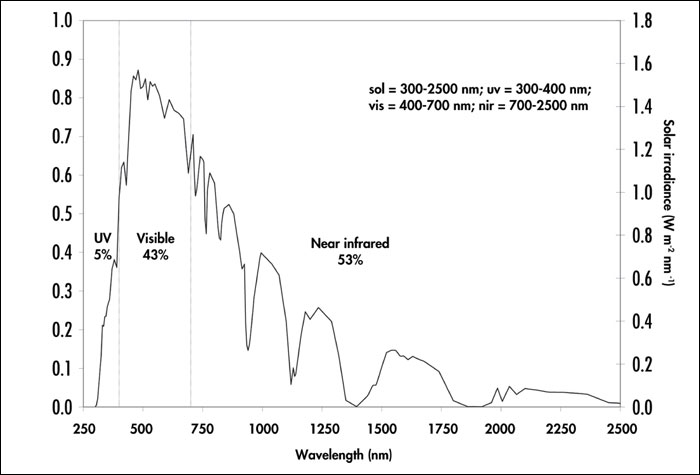
Figure 3: Hemispherical solar irradiance
For roofing granules, incorporating so-called cool pigments can increase solar reflectance; however, it also is necessary to consider other factors, such as the color coating efficiency, surface roughness of the mineral particles and shingle manufacturing process.
As previously mentioned, the color coating in roofing granules typically is not uniform, leaving a large portion of the mineral surface still exposed to direct solar heat, consequently reducing the benefits of using cool pigments. One solution is to use a white base coating or white prime coat to cover the mineral surfaces before finishing with a top color coat, as has been practiced by some roofing granule manufacturers. However, this approach often leads to a "wash out" color effect because the white base coat replaces the dark mineral surfaces as the background in a patchy coating coverage application.
Photos 1 and 2 show micrographs with a typical example of such products and their overall color effects compared with a standard non-solar reflective granule in a similar color family. When compared with industrial standard, non-solar reflective roofing granules, the solar reflective granules show improved solar reflectance; however, this is at the cost of losing color strength in the deep earth-tone range.
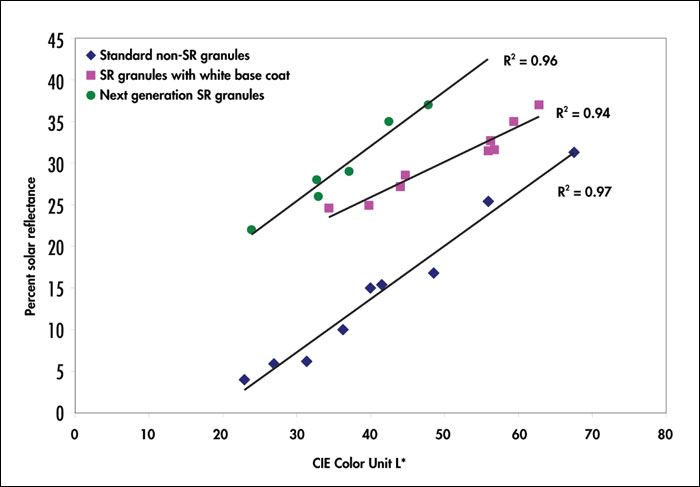
Figure 4: Solar reflectance versus the lightness L* for typical non-solar reflective granules, solar reflective granules with a white base coat and the new generation of solar reflective granules
Figure 4 shows solar reflectance as a function of lightness for three roofing granule types in a range of colors: standard non-solar reflective granules, solar reflective granules with a white base coat and the next generation solar reflective granules. Notice the solar reflectance of granules produced by using a white prime coat when traditionally manufacturing roofing granules tends to follow a similar linear relationship with L* but at a reduced slope. As a result, the solar reflectance improvement with this approach will be reduced as the color space expands. This suggests the use of a white base coat followed by a top color coat to improve a roof granule's solar reflectance may be limited in its efficiency to reach higher solar reflectance.
To further improve solar reflectance without sacrificing color strength, it is necessary to consider the surface characteristics of the mineral particles, coating efficiency and manufacturing processes. By optimizing these parameters, we have been able to further improve roofing granules' solar reflectance without affecting the final color. Compared with standard, non-solar reflective granules, these new generation solar reflective granules have similar color space yet a much higher solar reflectance.
When examined under a microscope, these granules have similar color aesthetics compared with standard, non-solar reflective granules. Furthermore, when this new generation of solar reflective granules is applied within the shingle-manufacturing process, it is possible to produce solar reflective shingles that closely match the traditional shingle color yet meet the ENERGY STAR® requirement for residential cool roof systems.
Field performance
To test the field performance of the new generation of solar reflective granules, asphalt shingles made with the granules were exposed to outdoor weathering in farms with three distinct climates: a hot, dry climate (Phoenix); hot, wet climate (Tampa, Fla.); and relatively cold, wet climate (Detroit). Their colors and changes in solar reflectance were recorded during a three-year period, and the results are shown in Figure 5. It is clear from the data the solar reflectance of these new generation solar reflective granules did not degrade during the time period. In fact, the shingles' overall total solar reflectance increased during three years of exposure in all three climates.
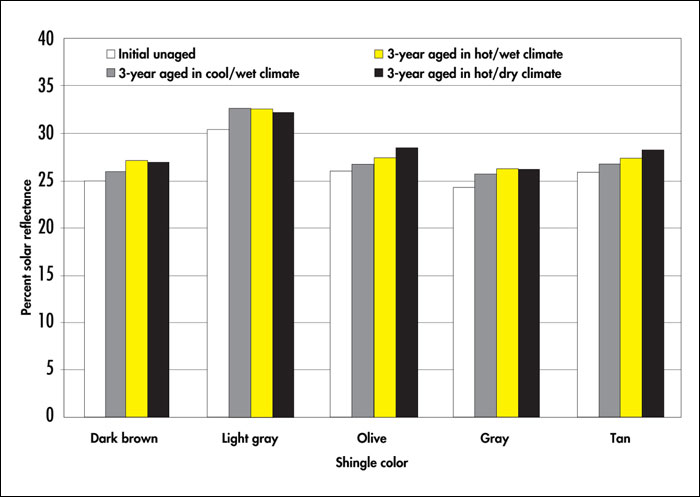
Figure 5: Weathering data of the new generation of solar reflective shingles
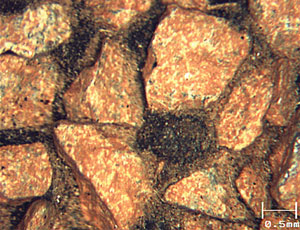
Photo 4: The surface of a three-year aged shingle with solar-reflective granules |
To further understand this phenomenon, the shingles' exposed surfaces were examined under a light microscope and compared with the unexposed, initial shingles with the same solar reflective granules (see Photos 3 and 4). No evidence of degradation in the color coating could be seen. However, the surface appeared to be covered by microscopic particles, particularly in areas between the roofing granules. Further analysis indicated these particles are likely to be airborne dust.
As a result, the total solar reflectance is found to slightly increase because the dark, absorbing areas of the bitumen between granules were found to be covered by dust.
A new frontier
We have demonstrated asphalt shingles can achieve high solar reflectance in traditional earth-tone colors by improving the solar reflectance values of surface roofing granules. This new generation of solar reflective roofing granules can be an effective solution for residential cool roof applications when homeowners also demand dark, vivid colors.
Field testing data has revealed the weathering performance of these new solar reflective granules is comparable to traditional roofing granules and their solar reflectance is equal or better than their initial stage after three years of aging in three distinct climates.
Ming L. Shiao is senior principal research engineer with CertainTeed Corp., Valley Forge, Pa., and Husnu M. Kalkanoglu is CertainTeed's vice president of research and development.

